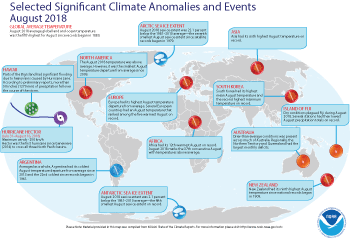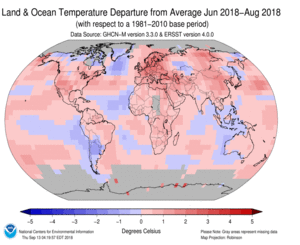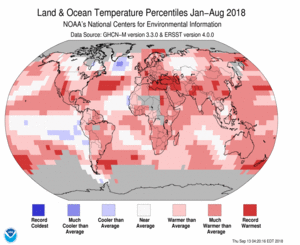Use the form below to select from a collection of monthly summaries recapping climate-related occurrences on both a global and national scale.
Global Climate ReportAugust 2018
Introduction
Temperature anomalies and percentiles are shown on the gridded maps below. The anomaly map on the left is a product of a merged land surface temperature (Global Historical Climatology Network, GHCN) and sea surface temperature (ERSST.v4) anomaly analysis as described in Huang et al. (2016). Temperature anomalies for land and ocean are analyzed separately and then merged to form the global analysis. For more information, please visit NCEI's Global Surface Temperature Anomalies page. The percentile map on the right provides additional information by placing the temperature anomaly observed for a specific place and time period into historical perspective, showing how the most current month, season or year compares with the past.
Temperatures
In the atmosphere, 500-millibar height pressure anomalies correlate well with temperatures at the Earth's surface. The average position of the upper-level ridges of high pressure and troughs of low pressure—depicted by positive and negative 500-millibar height anomalies on the August 2018 and June–August 2018 maps—is generally reflected by areas of positive and negative temperature anomalies at the surface, respectively.
August
August 2018 was characterized by warmer- to much-warmer-than-average conditions across much of the world's land and ocean surfaces. Record warm temperatures were present across parts of each major ocean basin, with the largest portions across the Barents Sea and the western Pacific Ocean, and small areas across Africa, Asia, Europe, and North America. During the month, the most notable temperature departures from average were present across Europe, central Asia, the northeastern contiguous U.S., and southeastern Canada, where temperatures were 2.0°C (3.6°F) above average or higher. In contrast, the most notable cool land temperature departures from average were present across northern Canada and parts of southern South America where temperatures were 1.5°C (2.7°F) below average or lower. No land or ocean areas had record cold August temperatures. Averaged as a whole, the global land and surface temperature for August 2018 was the fifth highest August temperature since global records began in 1880 at 0.74°C (1.33°F) above the 20th century average of 15.6°C (60.1°F). This was the smallest global land and ocean surface temperature since 2013. Nine of the ten warmest August global land and ocean surface temperatures have occurred since 2009, with the last five years (2014–2018) comprising the five warmest on record. The record warmest August occurred in 2016, with a temperature departure from average of +0.90°C (+1.62°F). August 1998 is the only 20th century August among the ten warmest Augusts on record, ranking as the seventh highest on record at +0.68°C (+1.22°F). August 2018 also marks the 42nd consecutive August and the 404th consecutive month with temperatures, at least nominally, above the 20th century average.
The globally-averaged land surface temperature during August 2018 was 0.94°C (1.69°F) above the 20th century average of 13.8°C (56.9°F)—the sixth highest August global land temperature in the 139-year record. Nine of the ten warmest August global land temperatures have occurred since 2001, with August 1998 the only 20th century August among the ten warmest Augusts on record. The highest global land August temperature occurred in 2016 at +1.28°C (+2.30°F). According to NCEI's Regional Analysis, two of six continents had an August temperature that ranked among the six warmest Augusts on record, with Europe having its warmest August on record. North America had its smallest temperature departure from average for August since 2009. South America and Africa's August 2018 temperature departure from average was the smallest since 2013.
Select national information is highlighted below. Please note that different countries report anomalies with respect to different base periods. The information provided here is based directly upon these data:
- Warmer-than-average temperatures engulfed much of Europe during August 2018, resulting in the warmest August since continental records began in 1910 at +2.40°C (+4.32°F). This value surpassed the previous record set in 2015 by +0.12°C (+0.22°F). There have been only three instances during the month of August where temperature departures from average for the continent were 2.0°C (3.6°F) or higher. These were 2003 (+2.17°C / +3.91°F), 2015 (+2.28°C / +4.10°F), and 2018.
- Germany had its third warmest August since national records began in 1881 at 20.0°C (68.0°F) or 2.5°C (4.5°F) above the 1981–2010 average.
- Austria's August temperature was 2.6°C (4.7°F) above the 1981–2010 average and the fifth highest for August in the nation's 252-year record.
- Spain's August 2018 mean temperature of 25.6°C (78.1°F) was 1.7°C (3.1°F) above the 1981–2010 average. This was also the second highest August temperature since national records began in 1965, trailing behind 2003 by +0.6°C (+1.1°F).
- Switzerland had its third warmest August since national records began in 1864 at 15.9°C (60.6°F), which is 2.1°C (3.8°F) above the 1981–2010 average.
- New Zealand had its ninth highest August temperature since national records began in 1909 at 9.7°C (49.5°F), which is 0.9°C (1.6°F) above the 1981–2010 average.
- August 2018 was South Korea's warmest August on record with a national mean temperature of 27.3°C (81.1°F), which is 2.2°C (4.0°F) above average. The nation's maximum (daytime) temperature ranked as the second highest at 32.2°C (90.0°F). National records began in 1973. According to KMA, many locations across South Korea set new maximum August temperature records. Of note, Seoul broke a 111-year record with a monthly maximum temperature of 39.6°C (103.3°F).
- While the northern half of Argentina had near- to cooler-than-average conditions, the southern half experienced warmer- to much-warmer-than-average conditions. Averaged as a whole, Argentina had its coolest August temperature departure from average since 2013. The nation's August 2018 temperature was 0.4°C (0.7°F) below average, ranking as the 22nd coldest August on record. The record cold August was set in 2007.
The global ocean temperature was 0.67°C (1.21°F) above average—the fifth highest on record. The years 2014–2018 comprise the five warmest Augusts on record, with 2015 the warmest August at 0.79°C (1.42°F) above average.
ENSO-neutral conditions persisted across the tropical Pacific Ocean during August 2018. According to NOAA's Climate Prediction Center, there is a 50–55% chance El Niño onset during the Northern Hemisphere fall 2018 (Southern Hemisphere spring), with an increasing chance of 65–70 during the Northern Hemisphere winter (Southern Hemisphere summer) 2018–19. This forecast focuses on the ocean surface temperatures between 5°N and 5°S latitude and 170°W to 120°W longitude, called the Niño 3.4 region.
Seasonal (June–August)
The period of June–August is defined as the Northern Hemisphere's summer and the Southern Hemisphere's winter.
The seasonal global land and ocean surface temperature for June–August 2018 was the fifth highest such period since global records began in 1880 at +0.74°C (+1.33°F). The last five years (2014–2018) comprise the five warmest June–August global temperatures on record, with 2016 the warmest at +0.90°C (+1.62°F). The three-month period was characterized by warmer- to much-warmer-than-average temperatures across much of the world's land and ocean surfaces, with the most notable warm temperature departures from average (+2.0°C / +3.6°F or higher) across Europe, central Asia, and the southwestern contiguous U.S. Record warm temperatures were present across parts of the Barents Sea, Europe, southern Asia, the western and south-central Pacific Ocean, and scattered across the Atlantic Ocean and North America. Cooler- to much-cooler-than-average conditions were limited to the North Atlantic Ocean, off the southern coast of Greenland, southern South America, and along the central South American coast.
Averaged separately, the global land surface temperature during June–August 2018 was the fifth highest June–August in the 139-year record at +1.02°C (+1.84°F). The global ocean temperature was 0.64°C (1.15°F) above average and tied with 2009 as the fifth highest on record. According to NCEI's Regional Analysis, four of six continents had a June–August temperature that ranked among the eight highest on record. South America had smallest temperature departure from average since 2010.
Select national information is highlighted below. (Please note that different countries report anomalies with respect to different base periods. The information provided here is based directly upon these data):
- Summer 2018 was Europe's warmest since continental records began in 1910 at +2.16°C (+3.89°F). This value surpassed the previous record set in 2003 by +0.26°C (+0.47°F). Summer 2018 also marked the first time the continent's summer temperature was 2.0°C (3.6°F) above average or higher in the 109-year record.
- France had its second hottest summer since national records began in 1900 at 21.2°C (70.2°F) or 2.0°C (3.6°F) above the 1981–2010 average. This value falls behind 2003 by 1.2°C (2.2°F). The year 2017 now ranks as the third warmest summer on record at +1.5°C (+2.7°F).
- Austria's summer 2018 temperature was the fourth highest in the nation's 252-year record at 2.0°C (3.6°F) above the 1981–2010 average, behind 2003 (+2.8°C / +5.0°F), 2015 (+2.4°C / +4.3°F), and 2017 (+2.1°C / +3.8°F).
- The summer 2018 temperature for Germany was 19.3°C (66.7°F), which is 2.2°C (4.0°F) above the 1981–2010 average and the second highest summer temperature since national records began in 1881, trailing behind 2003 by 0.4°C (0.7°F).
- The Netherlands had its highest summer temperature since national records began in over three centuries ago at 18.9°C (66.0°F) or 1.9°C (3.4°F) above average. This value surpasses the previous record set in 1826 by +0.2°C (+0.4°F).
- Switzerland's national summer temperature of 15.3°C (59.5°F) is 2.0°C (3.6°F) above the 1981–2010 average—the third highest summer temperature in the nation's 155-year record. This value falls behind 2003 and 2015.
- South Korea had its warmest summer since 1973.
- Argentina had its coldest June–August since 2007 and the eighth coldest since national records began in 1961.
- Australia's mean temperature during winter 2018 was 0.51°C (0.92°F) above the 1961–1990 average and the 21st warmest winter in the nation's 109-year record. The warmth was mainly driven by very warm maximum (daytime) temperatures since the minimum temperatures were cooler-than-average. The nation's maximum temperature departure from average was +1.23°C (+2.21°F)—the fifth highest since national temperature records began in 1910. Regionally, Queensland and New South Wales also had its fifth highest winter maximum temperature; Northern Territory had its sixth highest; and South Australia had its ninth highest on record.
- Winter 2018 was the sixth warmest on record for New Zealand at 9.0°C (48.2°F) or 0.6°C (1.1°F) above the 1981–2010 average. New Zealand's temperature records extend back to 1909. Several locations had record or near-record warm temperatures. Of note, Medbury had its highest winter mean temperature since records began for this station in 1927 at +1.3°C (+2.3°F).
Year-to-date (January–August)
The first eight months of the year have been extremely warm, giving way to the fourth highest January–August in the 139-year record at +0.76°C (+1.37°F). The value is 0.26°C (0.47°F) less than the record set in 2016. Nine of the ten warmest January–August periods have occurred since 2002, with the last four years (2015–2018) among the four warmest such periods on record. January–August 1998 is the only 20th century January–August among the ten warmest years on record, ranking as the seventh warmest such period on record. Record warm temperatures were scattered across all oceans and across most continents. Based on three simple scenarios, 2018 will likely end up among the six warmest years on record.
Averaged separately, the global land surface temperature for January–August was 1.16°C (2.09°F) above average and also the fourth highest since global records began in 1880. The global ocean temperature for January–August was the fifth highest on record at +0.61°C (+1.10°F).
According to NCEI's Regional Analysis, five of six continents had a January–August temperature that ranked among the ten warmest on record. Europe had its highest January–August temperature in the 109-year record at 1.83°C (3.29°F) above average. This value surpassed the previous record set in 2014 by +0.06°C (+0.11°F).
Precipitation
August
The maps below represent precipitation percent of normal (left, using a base period of 1961–1990) and precipitation percentiles (right, using the period of record) based on the GHCN dataset of land surface stations. As is typical, precipitation anomalies during August 2018 varied significantly around the world. August precipitation was generally drier than normal across the western half of the contiguous U.S., southern Canada, western Alaska, southern South America, Australia, central Europe, and across northern and southern Asia. Wetter-than-normal conditions were notable across the eastern half of the contiguous U.S., eastern Alaska, southern Brazil, Uruguay, Scandinavia, southwestern Australia, and central Asia.
Select national information is highlighted below. (Please note that different countries report anomalies with respect to different base periods. The information provided here is based directly upon these data):
- Drier-than-average conditions plagued the Island of Fiji during August 2018. According to Fiji's Meteorological Service, 24 of 25 stations had well-below-average precipitation during the month. Several stations (Nabouwalu, Laucala Bay, Monasavu, Vanuabalavu, and Tokotoko) had their lowest August precipitation totals since records began (1918, 1941, 1980, 1985, and 1992, respectively). Since little to no rainfall fell during the month, drought developed in some locations, affecting grasslands and small bodies of water.
- Argentina had drier-than-average conditions during August 2018, resulting in the seventh driest August at 43.7% below average. Records began in 1961.
- Much of Australia experienced drier-than-average conditions during the month, with a national average of 26% below the 1961–1990 average. Regionally, Northern Territory and Queensland had the largest monthly deficit at 76% and 68% below average, respectively. Tasmania and South Australia were the only regions that had above-average precipitation at 13% and 20% above average, respectively.
Seasonal (June–August)
Northern Hemisphere summer / Southern Hemisphere winter precipitation was generally drier than normal across the western half of the contiguous U.S, northeastern Brazil and parts of southern South America, central Europe, Russia, southern Asia, and much of Australia. Wetter-than-normal conditions were notable across the eastern half of the contiguous U.S., Alaska, southeastern Europe, Mongolia, and parts of Japan and India.
- Germany had its second driest summer on record at 130 mm (5.1 inches) of rain. Summer 1911 was the driest summer in the 139-year record at 124 mm (4.9 inches).
- Winter 2018 was drier-than-average for Australia at 33% below average and the 14th driest winter in the nation's 119-year record. Regionally, New South Wales had its driest winter since 2002 and the eighth driest since national precipitation records began in 1900. Of note, Tasmania was the only region with above-average precipitation at +23%.
References
- Peterson, T.C. and R.S. Vose, 1997: An Overview of the Global Historical Climatology Network Database. Bull. Amer. Meteorol. Soc., 78, 2837-2849.
- Huang, B., V.F. Banzon, E. Freeman, J. Lawrimore, W. Liu, T.C. Peterson, T.M. Smith, P.W. Thorne, S.D. Woodruff, and H-M. Zhang, 2016: Extended Reconstructed Sea Surface Temperature Version 4 (ERSST.v4). Part I: Upgrades and Intercomparisons. J. Climate, 28, 911-930.
 NOAA's National Centers for Environmental Information
NOAA's National Centers for Environmental Information


















